|

|





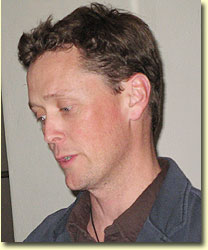 Since his first
vintage in 1999, Wells Guthrie's
Copain wines have represented both quality and consistency in the
“traditional” school, one that looks to Burgundy and the Rhone for
inspiration (not imitation), with an emphasis on balance and elegance
over power and richness. With a background working at Chapoutier
and extensive interaction with Gerard Chave,
it’s not surprising that Wells doesn’t share the point-centric tendency
to view “bigger” as always “better,” and while his wines have always had
depth, they also have been well-balanced and with moderate alcohol
levels (always under 15%), at least by modern California standards. Since his first
vintage in 1999, Wells Guthrie's
Copain wines have represented both quality and consistency in the
“traditional” school, one that looks to Burgundy and the Rhone for
inspiration (not imitation), with an emphasis on balance and elegance
over power and richness. With a background working at Chapoutier
and extensive interaction with Gerard Chave,
it’s not surprising that Wells doesn’t share the point-centric tendency
to view “bigger” as always “better,” and while his wines have always had
depth, they also have been well-balanced and with moderate alcohol
levels (always under 15%), at least by modern California standards.
The interesting thing about Copain, however, is that although the winery
has always been considered a member of the finesse and balance school,
in recent years Wells had become dissatisfied with his wines, finding
them too manipulated, too ripe, too alcoholic, and not developing as he
wanted. So beginning in 2006, Wells made some significant changes,
beginning with limiting his grape purchases to vineyards that could
produce quality grapes at ripeness levels much lower than he had
previously accepted. While previously he had bought fruit picked at 24°
or 25° Brix (fairly low by the standards of many), he now decided to
only buy grapes from vineyards that could produce phenolically ripe
fruit at 23.5°Brix, or less. He wants alcohol to be under 14%, and he’s
convinced that the wines will be more interesting, more age worthy, and
more delicious as a result. Rather than simply pick less ripe in every
vineyard, he’s focusing his efforts only on select vineyards that can do
this without producing wines that are too thin or too green. That means
that all of his Pinot Noirs are from Anderson Valley, and he’s gradually
restricting his Syrah purchases to a few select vineyards as well.
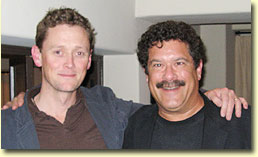 Last week, Wells joined us at Los Angeles’ Campanille Restaurant,
to share his latest pinots and syrahs, and to compare some of his older
vintages with worthy competitors from other schools of winemaking. Wells
graciously provided a range of his 2006 Pinot Noirs, and his
just-bottled (and not yet released) 2007 Syrahs, the first vintages
which fully express his new direction. The results speak for themselves.
(Photo: Wells Gutherie (L) with author, Bennett Traub) Last week, Wells joined us at Los Angeles’ Campanille Restaurant,
to share his latest pinots and syrahs, and to compare some of his older
vintages with worthy competitors from other schools of winemaking. Wells
graciously provided a range of his 2006 Pinot Noirs, and his
just-bottled (and not yet released) 2007 Syrahs, the first vintages
which fully express his new direction. The results speak for themselves.
(Photo: Wells Gutherie (L) with author, Bennett Traub) |
|
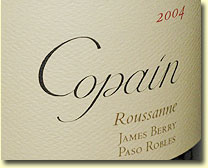 Starters: Two Roussannes. While I am not a big
fan of white Rhone varietals, I was very impressed with the 2004
Copain Roussanne James Berry Vineyard. Showing the floral side of
the varietal with some complex herbal notes, the wine is medium bodied
and avoids the thick texture I often find with domestic roussannes.
Despite coming from a hot Paso Robles vineyard, the wine had superb
balance and crisp acids, in structure more like a good white Burgundy
than a heavier Rhone wine. This is open for business and drinking very
well now, with plenty of life ahead. By comparison, the 2006 Copain
Roussanne James Berry Vineyard was pretty tight and not showing much
right now. With a similar flavor profile and structure to the 2004, it
clearly needs another year or two of cellaring to really show what its
got, but it seems balanced and deep enough to equal or exceed the 2004
eventually. Find these wines Starters: Two Roussannes. While I am not a big
fan of white Rhone varietals, I was very impressed with the 2004
Copain Roussanne James Berry Vineyard. Showing the floral side of
the varietal with some complex herbal notes, the wine is medium bodied
and avoids the thick texture I often find with domestic roussannes.
Despite coming from a hot Paso Robles vineyard, the wine had superb
balance and crisp acids, in structure more like a good white Burgundy
than a heavier Rhone wine. This is open for business and drinking very
well now, with plenty of life ahead. By comparison, the 2006 Copain
Roussanne James Berry Vineyard was pretty tight and not showing much
right now. With a similar flavor profile and structure to the 2004, it
clearly needs another year or two of cellaring to really show what its
got, but it seems balanced and deep enough to equal or exceed the 2004
eventually. Find these wines
Flight 1: 2006 Copain Pinot Noir: This is the first year that
Wells fully implemented his new approach, harvesting his grapes at lower
sugars. All of these wines come from the Anderson Valley, and they have
alcohol levels under 14%. They were actually poured in the reverse order
that Wells thought was appropriate, so I’ll list them here in the order
Wells indicated. The Cerise Vineyard Find this wine was the most open and
flamboyant wine of the group, showing a big nose of red berry fruits and
Bing cherry with some meaty and complex mineral notes. Great acid/fruit
balance here, with terrific brightness and verve lifting the intense
flavors, yet the body of the wine is fairly light (in a good way). The
next wine, the Monument Tree Vineyard Find this wine, was much more closed in by
comparison. More structured with ample smooth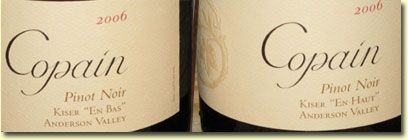 tannins that give a
slightly austere impression now, there is plenty of deep, slightly
darker fruit flavors and the body is slightly more dense than the
Cerise. This firmly structured wine will need age but seems perfectly
balanced and capable of developing very well. The next two wines are
both from the Kiser Vineyard, in the extreme “deep end” of the Anderson
Valley. The Kiser En Bas Find this wine is remarkably elegant, smooth and long,
with very deep red fruits and perfect balance. The flavors are intense,
yet the mouth feel is silky and gentle on the palate. Even more complex
and deeper is the Kiser En Haut Find this wine, a wine that somehow gives the
impression of being at the same time slightly “bigger” yet even more
elegant and graceful than the En Bas. The balance of fruit, tannin and
acid seems perfect, and although quite complex and enjoyable to drink
now, the wine seems poised to develop beautifully for quite some time.
My WOTF: Kiser En Haut, but really all of these wines were
beautiful. tannins that give a
slightly austere impression now, there is plenty of deep, slightly
darker fruit flavors and the body is slightly more dense than the
Cerise. This firmly structured wine will need age but seems perfectly
balanced and capable of developing very well. The next two wines are
both from the Kiser Vineyard, in the extreme “deep end” of the Anderson
Valley. The Kiser En Bas Find this wine is remarkably elegant, smooth and long,
with very deep red fruits and perfect balance. The flavors are intense,
yet the mouth feel is silky and gentle on the palate. Even more complex
and deeper is the Kiser En Haut Find this wine, a wine that somehow gives the
impression of being at the same time slightly “bigger” yet even more
elegant and graceful than the En Bas. The balance of fruit, tannin and
acid seems perfect, and although quite complex and enjoyable to drink
now, the wine seems poised to develop beautifully for quite some time.
My WOTF: Kiser En Haut, but really all of these wines were
beautiful.
Flight 2: 2007 Copain Syrahs: These wines had been bottled only a
month ago, so were more like final barrel samples rather than finished
wines, yet they showed very well indeed. All of the alcohols are under
14%. Wells’ favorite is the Hawks Butte Find this wine, which showed a big nose
of Asian spices, blue/black fruits and complex mineral notes, all framed
by great acid/fruit balance and smooth tannins. This is very bright,
rich yet not heavy or thick, and tasting great already. More closed and
awkward by comparison was the Baker Ranch Find this wine, a bit lighter than the
Hawks Butte and seemingly a little more austere at this point as well.
There’s plenty of deep fruit, but it’s more restrained now, holding
back. Hints of coffee emerged with air, but this clearly needs some time
to show its stuff. The Garys Find this wine was much more showy, bigger, riper
and denser. I got some chocolate along with the Asian spices and some
licorice notes. By comparison with the other wines in the flight, this
has more thickness and tannins, yet is still quite smooth and supple in
a more large-scaled package. Last was the Brousseau Find this wine, which Wells
stated he had to pick a bit earlier than he wanted because the fruit was
being decimated on the vine by marauding feral pigs! As a result, the
wine is quite acidic, not too much for me, but about as tart as I would
want. Yet there is terrific complexity with black cherry and garrigue
herbs along with the most minerality of the wines in this group. The
aromatics are very attractive and have some pit-fruit elements that
suggest some viognier was co-fermented (but no, it’s all syrah). It will
be interesting to see how this evolves; if the fruit holds, the acidity
would seem to assure a long life. My WOTF: Hawks Butte, but the
Brousseau is a close second.
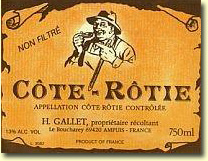 Flight 3: Copain & Cayuse Syrahs from Washington: For a few years
(2001-2005), Copain obtained fruit from two Washington vineyards
(Cailloux and Coccinelle) that have become well-known mainly as the
mainstays of the Cayuse winery. Wells combined the fruit from these into
a single blend, whereas Cayuse bottles them individually. We were
supposed to taste the 2002 Copain version, but it didn’t make it, so a
2004 Cote Rotie, H. Gallet Find this wine was added to provide an “old world”
perspective. Fairly hard and austere, not showing much aroma, but with
plenty of fruit under the surface that was quite different in flavor
from the wines that followed. Lots of pit fruits and mineral notes along
with some Asian spices, in a fairly lean package at this point, but not
too tannic or acidic—well balanced. This clearly needs at least another
5 years, but doesn’t seem to have the depth for really long-term aging,
and overall it’s a good but not great Cote Rotie. Next was the 2004
Copain Cailloux & Coccinelle Syrah. I got a lot of stewed tomato
aromas on this one, seems quite ripe and pretty soft, with a flat aspect
to the acidity (what there is of it). The wine has decent fruit but
lacks grip and is not clearly identifiable as syrah; it has some
minerality, but is also tannic and short. Decent but this got a bit too
ripe and lost its focus, in my opinion. Still, it was much better than
the 2003 Cayuse Coccinelle
Find these wines , which was one of the worst wines of
the night. Sharp sweet & sour nose of prunes and fumy alcohol much like
an overripe Barossa shiraz, disjointed, pruney/dried fruit on the entry,
then a hollow middle and a sharp, hot finish. This seems to be falling
apart, if it was ever together to begin with. The 2006 Cayuse
Cailloux
Find these wines that followed was better, but not that much. Very dense and
full-bodied, but also very hot, this at least has some syrah character
lacking in the 2003 Coccinelle and not as pruney, but still very low in
acidity and flat, and airing accentuated these attributes. This is going
nowhere and needs to be drunk soon (if at all). I was a buyer of Cayuse
in its early days, but I’m perfectly happy to be off their list now.
My WOTF: 2004 Cote Rotie. Flight 3: Copain & Cayuse Syrahs from Washington: For a few years
(2001-2005), Copain obtained fruit from two Washington vineyards
(Cailloux and Coccinelle) that have become well-known mainly as the
mainstays of the Cayuse winery. Wells combined the fruit from these into
a single blend, whereas Cayuse bottles them individually. We were
supposed to taste the 2002 Copain version, but it didn’t make it, so a
2004 Cote Rotie, H. Gallet Find this wine was added to provide an “old world”
perspective. Fairly hard and austere, not showing much aroma, but with
plenty of fruit under the surface that was quite different in flavor
from the wines that followed. Lots of pit fruits and mineral notes along
with some Asian spices, in a fairly lean package at this point, but not
too tannic or acidic—well balanced. This clearly needs at least another
5 years, but doesn’t seem to have the depth for really long-term aging,
and overall it’s a good but not great Cote Rotie. Next was the 2004
Copain Cailloux & Coccinelle Syrah. I got a lot of stewed tomato
aromas on this one, seems quite ripe and pretty soft, with a flat aspect
to the acidity (what there is of it). The wine has decent fruit but
lacks grip and is not clearly identifiable as syrah; it has some
minerality, but is also tannic and short. Decent but this got a bit too
ripe and lost its focus, in my opinion. Still, it was much better than
the 2003 Cayuse Coccinelle
Find these wines , which was one of the worst wines of
the night. Sharp sweet & sour nose of prunes and fumy alcohol much like
an overripe Barossa shiraz, disjointed, pruney/dried fruit on the entry,
then a hollow middle and a sharp, hot finish. This seems to be falling
apart, if it was ever together to begin with. The 2006 Cayuse
Cailloux
Find these wines that followed was better, but not that much. Very dense and
full-bodied, but also very hot, this at least has some syrah character
lacking in the 2003 Coccinelle and not as pruney, but still very low in
acidity and flat, and airing accentuated these attributes. This is going
nowhere and needs to be drunk soon (if at all). I was a buyer of Cayuse
in its early days, but I’m perfectly happy to be off their list now.
My WOTF: 2004 Cote Rotie.
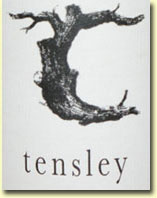 Flight 4: Copain & Tensley Thompson Syrahs: Thompson Vineyard,
near Los Alamos in a fairly warm section of Santa Barbara County, would
appear to be an interesting vineyard to compare the work of the
finesse-oriented Wells, and the more robust style of Joey Tensley
(former assistant winemaker at Beckmen). As it turned out, only one
Copain was represented, as the 2005 Copain Thompson Find this wine was corked.
The 2004 Copain Thompson Syrah Find this wine was quite ripe with a slight hint
of dried fruit and prune, as well as chocolate-covered blackberries.
Much thicker in texture than the 2007 Copain Syrahs, with adequate but
not great acid, and a heavy feel on the palate. Pretty good in a ripe
style, but one-dimensional at this point. The 2003 Tensley Thompson
Syrah Find this wine was quite fragrant at first, with some nice floral notes and
seemingly good balance, but the wine didn’t seem to hold up very well as
it aired, getting a bit dull and lifeless. Still, this wa s pretty good
in my book, and not an over-the-top style. The 2005 Tensley Thompson
Syrah Find this wine was much riper, with more blackberry and intense, deep fruit
but not pruney. Again somewhat one-dimensional and totally
fruit-dominated. Good if you like the totally fruit-forward style, but
lacking complexity at this point in its evolution. Thompson syrahs have
the reputation of needing considerable aging, so we’ll see, but the acid
in the Tensley wines was at least decent, so there’s some hope there.
My WOTF: 2003 Tensley. Flight 4: Copain & Tensley Thompson Syrahs: Thompson Vineyard,
near Los Alamos in a fairly warm section of Santa Barbara County, would
appear to be an interesting vineyard to compare the work of the
finesse-oriented Wells, and the more robust style of Joey Tensley
(former assistant winemaker at Beckmen). As it turned out, only one
Copain was represented, as the 2005 Copain Thompson Find this wine was corked.
The 2004 Copain Thompson Syrah Find this wine was quite ripe with a slight hint
of dried fruit and prune, as well as chocolate-covered blackberries.
Much thicker in texture than the 2007 Copain Syrahs, with adequate but
not great acid, and a heavy feel on the palate. Pretty good in a ripe
style, but one-dimensional at this point. The 2003 Tensley Thompson
Syrah Find this wine was quite fragrant at first, with some nice floral notes and
seemingly good balance, but the wine didn’t seem to hold up very well as
it aired, getting a bit dull and lifeless. Still, this wa s pretty good
in my book, and not an over-the-top style. The 2005 Tensley Thompson
Syrah Find this wine was much riper, with more blackberry and intense, deep fruit
but not pruney. Again somewhat one-dimensional and totally
fruit-dominated. Good if you like the totally fruit-forward style, but
lacking complexity at this point in its evolution. Thompson syrahs have
the reputation of needing considerable aging, so we’ll see, but the acid
in the Tensley wines was at least decent, so there’s some hope there.
My WOTF: 2003 Tensley.
 Flight 5: Copain & Saxum James Berry Syrahs: If any vineyard
would seem less suited to Wells’ current stylistic choices, it would
appear to be the James Berry Vineyard, Paso Robles’ “Grand Cru” and the
source of some of the biggest and ripest syrahs in America. The 2004
Copain James Berry Syrah Find this wine was every bit as ripe as expected, and very
intensely flavored, but with decent balance that appeared to have enough
acidity (barely) to keep it going for a while. Lots of blueberry fruit
and licorice, not much minerality or complexity, this is a fruit-bomb
that’s at least well put together. The 2005 Copain James Berry Syrah
Find this wine was brighter and better balanced than the 2004, not as dense and better
for it. Still totally primary and quite ripe, the fruit is very deep and
dark, but the wine does not go over-the-top. Not so the 2004 Saxum James Berry—Bone Rock Syrah Find this wine, which appears to have completely fallen
apart. Very soft and syrupy, with hints of brett, no acid, soupy, hot,
and devoid of any tannin or acid structure to give the wine some shape
or definition. Saxum clearly had a very poor year in 2004, an opinion
that up until now had seemed limited to their other ‘lesser’ bottling,
but now the Bone Rock is showing many of the same problems the other
Saxums of this vintage have shown for some time. The 2005 Saxum James Berry—Bone Rock Find this wine was better, but not as much so as I would have hoped
or expected. Very dense, thick and soft, there is a bit more acid/tannin
structure to support the massive superstructure of ultra-ripe fruit, but
the wine just seems heavy and dull right now, and I wonder if there’s
enough grip to sustain the wine long enough to emerge into something
more interesting. Disappointing. My WOTF: 2005 Copain. Flight 5: Copain & Saxum James Berry Syrahs: If any vineyard
would seem less suited to Wells’ current stylistic choices, it would
appear to be the James Berry Vineyard, Paso Robles’ “Grand Cru” and the
source of some of the biggest and ripest syrahs in America. The 2004
Copain James Berry Syrah Find this wine was every bit as ripe as expected, and very
intensely flavored, but with decent balance that appeared to have enough
acidity (barely) to keep it going for a while. Lots of blueberry fruit
and licorice, not much minerality or complexity, this is a fruit-bomb
that’s at least well put together. The 2005 Copain James Berry Syrah
Find this wine was brighter and better balanced than the 2004, not as dense and better
for it. Still totally primary and quite ripe, the fruit is very deep and
dark, but the wine does not go over-the-top. Not so the 2004 Saxum James Berry—Bone Rock Syrah Find this wine, which appears to have completely fallen
apart. Very soft and syrupy, with hints of brett, no acid, soupy, hot,
and devoid of any tannin or acid structure to give the wine some shape
or definition. Saxum clearly had a very poor year in 2004, an opinion
that up until now had seemed limited to their other ‘lesser’ bottling,
but now the Bone Rock is showing many of the same problems the other
Saxums of this vintage have shown for some time. The 2005 Saxum James Berry—Bone Rock Find this wine was better, but not as much so as I would have hoped
or expected. Very dense, thick and soft, there is a bit more acid/tannin
structure to support the massive superstructure of ultra-ripe fruit, but
the wine just seems heavy and dull right now, and I wonder if there’s
enough grip to sustain the wine long enough to emerge into something
more interesting. Disappointing. My WOTF: 2005 Copain.
This was a fascinating tasting and quite a revelation. Wells was
remarkably candid in his evaluation of the wines, including his own. He
was almost brutal in his assessment of his own prior efforts, admitting
that to his palate they were not aging as he had hoped, lacking the kind
of energy and finesse he believes the finest wines ought to possess. He
clearly feels that his new approach is creating not only better wines
for now, but ones which will age and improve much more successfully than
his past efforts. I think he’s being overly harsh about his prior wines,
many of which I think have aged beautifully and are delicious, but his
new direction appears to be creating some exciting results.
It will be interesting to see if he can sustain this approach over
multiple vintages. Recent years have been relatively cool in many of the
regions where Wells is sourcing his fruit, making lower
alcohol/finesse-oriented wines somewhat easier to make. Even some
members of the “big/ripe fruit” school like Kosta Browne have made wines
with somewhat lower alcohol in ’06 and ’07. Can Wells continue to do so
in hot years, and particularly in hot-area vineyards like Paso Robles’
James Berry? This will be a very interesting story to follow.
Most of our group was very impressed with both the pinots and the syrahs.
I wonder if the poor showing of many of the syrahs in the later flights
was related to the “context” created by Wells’ 2007’s—his wines just
seemed so much more energetic, complex, and alive than the riper,
larger-scaled wines that followed, including the older vintages of
Copain. After the tasting, a number in our group commented that they
were becoming increasingly tired of the “big fruit” style that all of us
have enjoyed and bought in recent years, so perhaps Wells is really onto
something here. In any event, this will be a very interesting story to
follow. Personally, I’m not prepared to dismiss all the riper style
wines being made, many of which I continue to buy and enjoy, as this was
far from a comprehensive evaluation. But I’m going to be looking a lot
harder at the alternatives.
Bennett Traub
Reporting From The Left Coast
Send Bennett an
|



|